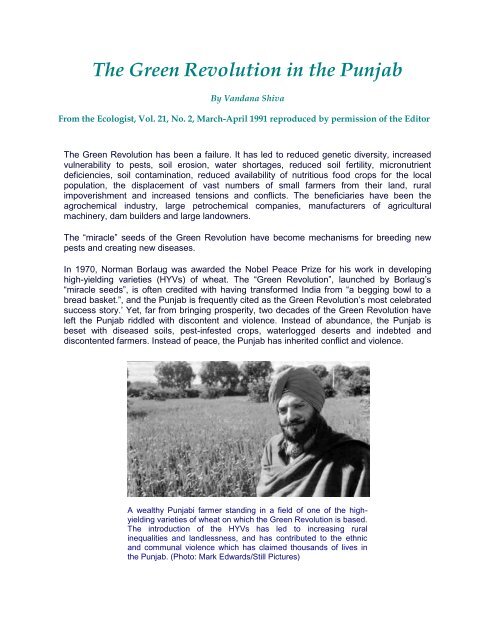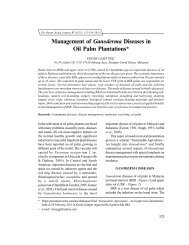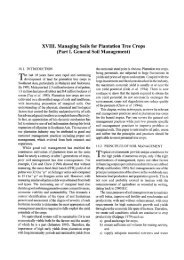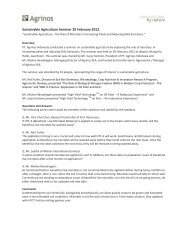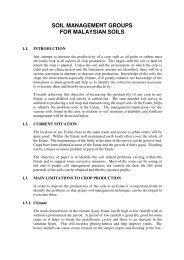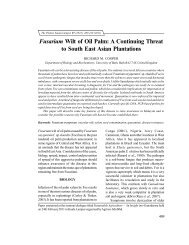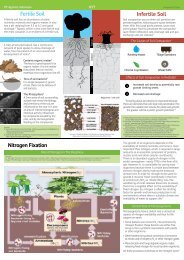The Green Revolution in the Punjab.pdf
The Green Revolution in the Punjab.pdf
The Green Revolution in the Punjab.pdf
You also want an ePaper? Increase the reach of your titles
YUMPU automatically turns print PDFs into web optimized ePapers that Google loves.
<strong>The</strong> <strong>Green</strong> <strong>Revolution</strong> <strong>in</strong> <strong>the</strong> <strong>Punjab</strong><br />
By Vandana Shiva<br />
From <strong>the</strong> Ecologist, Vol. 21, No. 2, March-April 1991 reproduced by permission of <strong>the</strong> Editor<br />
<strong>The</strong> <strong>Green</strong> <strong>Revolution</strong> has been a failure. It has led to reduced genetic diversity, <strong>in</strong>creased<br />
vulnerability to pests, soil erosion, water shortages, reduced soil fertility, micronutrient<br />
deficiencies, soil contam<strong>in</strong>ation, reduced availability of nutritious food crops for <strong>the</strong> local<br />
population, <strong>the</strong> displacement of vast numbers of small farmers from <strong>the</strong>ir land, rural<br />
impoverishment and <strong>in</strong>creased tensions and conflicts. <strong>The</strong> beneficiaries have been <strong>the</strong><br />
agrochemical <strong>in</strong>dustry, large petrochemical companies, manufacturers of agricultural<br />
mach<strong>in</strong>ery, dam builders and large landowners.<br />
<strong>The</strong> “miracle” seeds of <strong>the</strong> <strong>Green</strong> <strong>Revolution</strong> have become mechanisms for breed<strong>in</strong>g new<br />
pests and creat<strong>in</strong>g new diseases.<br />
In 1970, Norman Borlaug was awarded <strong>the</strong> Nobel Peace Prize for his work <strong>in</strong> develop<strong>in</strong>g<br />
high-yield<strong>in</strong>g varieties (HYVs) of wheat. <strong>The</strong> “<strong>Green</strong> <strong>Revolution</strong>”, launched by Borlaug‟s<br />
“miracle seeds”, is often credited with hav<strong>in</strong>g transformed India from “a begg<strong>in</strong>g bowl to a<br />
bread basket.”, and <strong>the</strong> <strong>Punjab</strong> is frequently cited as <strong>the</strong> <strong>Green</strong> <strong>Revolution</strong>‟s most celebrated<br />
success story.‟ Yet, far from br<strong>in</strong>g<strong>in</strong>g prosperity, two decades of <strong>the</strong> <strong>Green</strong> <strong>Revolution</strong> have<br />
left <strong>the</strong> <strong>Punjab</strong> riddled with discontent and violence. Instead of abundance, <strong>the</strong> <strong>Punjab</strong> is<br />
beset with diseased soils, pest-<strong>in</strong>fested crops, waterlogged deserts and <strong>in</strong>debted and<br />
discontented farmers. Instead of peace, <strong>the</strong> <strong>Punjab</strong> has <strong>in</strong>herited conflict and violence.<br />
A wealthy <strong>Punjab</strong>i farmer stand<strong>in</strong>g <strong>in</strong> a field of one of <strong>the</strong> highyield<strong>in</strong>g<br />
varieties of wheat on which <strong>the</strong> <strong>Green</strong> <strong>Revolution</strong> is based.<br />
<strong>The</strong> <strong>in</strong>troduction of <strong>the</strong> HYVs has led to <strong>in</strong>creas<strong>in</strong>g rural<br />
<strong>in</strong>equalities and landlessness, and has contributed to <strong>the</strong> ethnic<br />
and communal violence which has claimed thousands of lives <strong>in</strong><br />
<strong>the</strong> <strong>Punjab</strong>. (Photo: Mark Edwards/Still Pictures)
Orig<strong>in</strong>s<br />
It has often been argued that <strong>the</strong> <strong>Green</strong> <strong>Revolution</strong> provided <strong>the</strong> only way <strong>in</strong> which India<br />
(and, <strong>in</strong>deed, <strong>the</strong> rest of <strong>the</strong> Third World) could have <strong>in</strong>creased food availability. Yet, until <strong>the</strong><br />
1960s, India was successfully pursu<strong>in</strong>g an agricultural development policy based on<br />
streng<strong>the</strong>n<strong>in</strong>g <strong>the</strong> ecological base of agriculture and <strong>the</strong> self-reliance of peasants. Land<br />
reform was viewed as a political necessity and, follow<strong>in</strong>g <strong>in</strong>dependence; most states <strong>in</strong>itiated<br />
measures to secure tenure for tenant cultivators, to fix reasonable rents and to abolish<br />
<strong>the</strong> zam<strong>in</strong>dari (landlord) system. Ceil<strong>in</strong>gs on land hold<strong>in</strong>gs were also <strong>in</strong>troduced. In 1951, at a<br />
sem<strong>in</strong>ar organized by <strong>the</strong> M<strong>in</strong>istry of Agriculture, a detailed farm<strong>in</strong>g strategy—<strong>the</strong> “land<br />
transformation” programme — was put forward. <strong>The</strong> strategy recognized <strong>the</strong> need to plan<br />
from <strong>the</strong> bottom, to consider every <strong>in</strong>dividual village and sometimes every <strong>in</strong>dividual field.<br />
<strong>The</strong> programme achieved major successes. Indeed, <strong>the</strong> rate of growth of total crop<br />
production was higher dur<strong>in</strong>g this period than <strong>in</strong> <strong>the</strong> years follow<strong>in</strong>g <strong>the</strong> <strong>in</strong>troduction of <strong>the</strong><br />
<strong>Green</strong> <strong>Revolution</strong>.<br />
However, while Indian scientists and policy makers were work<strong>in</strong>g out self-reliant and<br />
ecologically sound alternatives for <strong>the</strong> regeneration of agriculture <strong>in</strong> India, ano<strong>the</strong>r vision of<br />
agricultural development was tak<strong>in</strong>g shape with<strong>in</strong> <strong>the</strong> <strong>in</strong>ternational aid agencies and large US<br />
foundations. Alarmed by grow<strong>in</strong>g peasant unrest <strong>in</strong> <strong>the</strong> newly <strong>in</strong>dependent countries of Asia,<br />
agencies like <strong>the</strong> World Bank, <strong>the</strong> Rockefeller and Ford Foundations, <strong>the</strong> US Agency for<br />
International Development and o<strong>the</strong>rs looked towards <strong>the</strong> <strong>in</strong>tensification of agriculture as a<br />
means of “stabiliz<strong>in</strong>g” <strong>the</strong> countryside - and <strong>in</strong> particular of defus<strong>in</strong>g <strong>the</strong> call for a wider<br />
redistribution of land and o<strong>the</strong>r resources. Above all, <strong>the</strong> US wished to avoid o<strong>the</strong>r Asian<br />
countries‟ follow<strong>in</strong>g <strong>in</strong> <strong>the</strong> revolutionary footsteps of Ch<strong>in</strong>a. In 1961, <strong>the</strong> Ford Foundation thus<br />
launched its Intensive Agricultural Development Programme <strong>in</strong> India, <strong>in</strong>tended to “release”<br />
Indian agriculture from “<strong>the</strong> shackles of <strong>the</strong> past” through <strong>the</strong> <strong>in</strong>troduction of modern <strong>in</strong>tensive<br />
chemical farm<strong>in</strong>g.<br />
Spray<strong>in</strong>g pesticides <strong>in</strong> India. Due to poverty, irresponsible<br />
employers and ignorance about <strong>the</strong>ir health effects, pesticides are<br />
frequently used without protective cloth<strong>in</strong>g <strong>in</strong> <strong>the</strong> Third World.<br />
(Photo: Mark Edwards/Still Pictures)
Add<strong>in</strong>g to <strong>the</strong> perceived geopolitical need to <strong>in</strong>tensify agriculture was pressure from western<br />
agrochemical companies anxious to ensure higher fertilizer consumption overseas. S<strong>in</strong>ce <strong>the</strong><br />
early 1950s, <strong>the</strong> Ford Foundation had been push<strong>in</strong>g for <strong>in</strong>creased fertilizer use by Indian<br />
farmers, as had <strong>the</strong> World Bank and USAID - with some success. Whilst <strong>the</strong> government‟s<br />
First Five Year Plan viewed artificial fertilizers as supplementary to organic manures, <strong>the</strong><br />
second and subsequent plans gave a direct and crucial role to fertilizers. But native varieties<br />
of wheat tend to “lodge”, or fall over, when subject to <strong>in</strong>tensive fertilizer applications. <strong>The</strong> new<br />
„dwarf‟ varieties developed by Borlaug, however, were specifically designed to overcome this<br />
problem: shorter and stiffer stemmed, <strong>the</strong>y could absorb chemical fertilizer, to which <strong>the</strong>y<br />
were highly receptive, without lodg<strong>in</strong>g.<br />
By <strong>the</strong> mid 1960s, India‟s agricultural policies were geared to push<strong>in</strong>g <strong>the</strong> <strong>in</strong>troduction of <strong>the</strong><br />
new “miracle” seeds developed by Borlaug. <strong>The</strong> programme came to be known as <strong>the</strong> New<br />
Agricultural Strategy. It concentrated on one-tenth of <strong>the</strong> arable land, and <strong>in</strong>itially on only one<br />
crop—wheat. By 1968, nearly half <strong>the</strong> wheat planted came from Borlaug‟s dwarf varieties.<br />
A host of new <strong>in</strong>stitutions were established to provide <strong>the</strong> research required to develop<br />
fur<strong>the</strong>r <strong>the</strong> <strong>Green</strong> <strong>Revolution</strong>, to dissem<strong>in</strong>ate <strong>the</strong> seeds, and to educate people <strong>in</strong> <strong>the</strong><br />
appropriate agricultural techniques. By 1969, <strong>the</strong> Rockefeller Foundation, <strong>in</strong> co-operation with<br />
<strong>the</strong> Ford Foundation, had established <strong>the</strong> Centro International de Agriculture Tropical (CIAT)<br />
<strong>in</strong> Colombia and <strong>the</strong> International Institute for Tropical Agriculture (IITA) <strong>in</strong> Nigeria. In 197 1,<br />
at <strong>the</strong> <strong>in</strong>itiative of Robert McNamara, <strong>the</strong> President of <strong>the</strong> World Bank, <strong>the</strong> Consultative<br />
Group on International Agricultural Research (CGIAR) was formed to f<strong>in</strong>ance <strong>the</strong> grow<strong>in</strong>g<br />
network of <strong>in</strong>ternational agricultural centres (IARCs). S<strong>in</strong>ce 1971, n<strong>in</strong>e more IARCs have<br />
been added to <strong>the</strong> CGIAR system. Over <strong>the</strong> last two decades, FAO has played a key role <strong>in</strong><br />
promot<strong>in</strong>g <strong>the</strong> <strong>Green</strong> <strong>Revolution</strong> package of “improved” seeds, agrochemicals and irrigation<br />
schemes.<br />
<strong>The</strong> Myth of High Yields<br />
<strong>The</strong> term “high-yield<strong>in</strong>g varieties” is a misnomer, because it implies that <strong>the</strong> new seeds are<br />
high yield<strong>in</strong>g of <strong>the</strong>mselves. <strong>The</strong> dist<strong>in</strong>guish<strong>in</strong>g feature of <strong>the</strong> seeds, however, is that <strong>the</strong>y are<br />
highly responsive to certa<strong>in</strong> key <strong>in</strong>puts such as fertilizers and irrigation water. <strong>The</strong> term “high<br />
responsive varieties” is thus more appropriate.<br />
In <strong>the</strong> absence of additional <strong>in</strong>puts of fertilizers and water, <strong>the</strong> new seeds perform worse than<br />
<strong>in</strong>digenous varieties. <strong>The</strong> ga<strong>in</strong> <strong>in</strong> output is <strong>in</strong>significant compared to <strong>the</strong> <strong>in</strong>crease <strong>in</strong> <strong>in</strong>puts.<br />
<strong>The</strong> measurement of output is also biased by restrict<strong>in</strong>g it to <strong>the</strong> marketable elements of<br />
crops. But, <strong>in</strong> a country like India, crops have traditionally been bred to produce not just food<br />
for humans, but fodder for animals and organic fertilizer for soils. In <strong>the</strong> breed<strong>in</strong>g strategy for<br />
<strong>the</strong> <strong>Green</strong> <strong>Revolution</strong>, multiple uses of plant biomass seem to have been consciously<br />
sacrificed for a s<strong>in</strong>gle use. An <strong>in</strong>crease <strong>in</strong> <strong>the</strong> marketable output of gra<strong>in</strong> has been achieved<br />
at <strong>the</strong> cost of a decrease <strong>in</strong> <strong>the</strong> biomass available for animals and soils from, for example,<br />
stems and leaves, and a decrease <strong>in</strong> ecosystem productivity due to <strong>the</strong> over-use of<br />
resources.
Significantly, much of <strong>the</strong> <strong>in</strong>creased yield obta<strong>in</strong>ed by plant<strong>in</strong>g <strong>the</strong> new HYV varieties consists<br />
of water. Increas<strong>in</strong>g <strong>the</strong> nitrogen uptake of plants through us<strong>in</strong>g artificial fertilizers upsets<br />
<strong>the</strong>ir carbon/ nitrogen balance, caus<strong>in</strong>g metabolic problems to which <strong>the</strong> plant reacts primarily<br />
by tak<strong>in</strong>g up extra water.<br />
India is a centre of genetic diversity of rice. Out of this diversity, Indian peasants and tribals<br />
have selected and improved many <strong>in</strong>digenous high yield<strong>in</strong>g varieties. Comparative studies of<br />
22 rice grow<strong>in</strong>g systems have shown that <strong>in</strong>digenous systems are more efficient when <strong>in</strong>puts<br />
of labour and energy are taken <strong>in</strong>to account. 2<br />
Loss of Diversity<br />
Diversity is a central pr<strong>in</strong>ciple of traditional agriculture <strong>in</strong> <strong>the</strong> <strong>Punjab</strong>, as <strong>in</strong> <strong>the</strong> rest of India.<br />
Such diversity contributed to ecological stability, and hence to ecosystem productivity. <strong>The</strong><br />
lower <strong>the</strong> diversity <strong>in</strong> an ecosystem, <strong>the</strong> higher its vulnerability to pests and disease.<br />
<strong>The</strong> <strong>Green</strong> <strong>Revolution</strong> package has reduced genetic diversity at two levels. First, it replaced<br />
mixtures and rotations of crops like wheat, maize, millets, pulses and oil seeds with<br />
monocultures of wheat and rice. Second, <strong>the</strong> <strong>in</strong>troduced wheat and rice varieties came from<br />
a very narrow genetic base. Of <strong>the</strong> thousands of dwarf varieties bred by Borlaug, only three<br />
were eventually used <strong>in</strong> <strong>the</strong> <strong>Green</strong> <strong>Revolution</strong>. On this narrow and alien genetic base <strong>the</strong><br />
food supplies of millions are precariously perched.<br />
Increas<strong>in</strong>g Pesticide Use<br />
Because of <strong>the</strong>ir narrow genetic base, HYVs are <strong>in</strong>herently vulnerable to major pests and<br />
diseases. As <strong>the</strong> Central Rice Research Institute, <strong>in</strong> Cuttack, India, notes of rice: “<strong>The</strong><br />
<strong>in</strong>troduction of high yield<strong>in</strong>g varieties has brought about a marked change <strong>in</strong> <strong>the</strong> status of<br />
<strong>in</strong>sect pests like gall midge, brown planthopper, leaf-folder, whore maggot, etc. Most of <strong>the</strong><br />
high-yield<strong>in</strong>g varieties released so far are susceptible to major pests with a crop loss of 30-<br />
100 per cent.” 3 Even where new varieties are specially bred for resistance to disease,<br />
“breakdown <strong>in</strong> resistance can occur rapidly and <strong>in</strong> some <strong>in</strong>stances replacement varieties may<br />
be required every three years or so.” 4 In <strong>the</strong> <strong>Punjab</strong>, <strong>the</strong> rice variety PR 106, which currently<br />
accounts for 80 per cent of <strong>the</strong> area under rice cultivation, was considered resistant to<br />
whitebacked planthopper and stem rot when it was <strong>in</strong>troduced <strong>in</strong> 1976. It has s<strong>in</strong>ce become<br />
susceptible to both diseases, <strong>in</strong> addition to succumb<strong>in</strong>g to rice leaf-folder, hispa, stemborer<br />
and several o<strong>the</strong>r <strong>in</strong>sect pests.<br />
<strong>The</strong> natural vulnerability of HYVs to pests has been exacerbated by o<strong>the</strong>r aspects of <strong>the</strong><br />
<strong>Green</strong> <strong>Revolution</strong> package. Large-scale monoculture provides a large and often permanent<br />
niche for pests, turn<strong>in</strong>g m<strong>in</strong>or diseases <strong>in</strong>to epidemics; <strong>in</strong> addition, fertilizers have been found<br />
to lower plants‟ resistance to pests. <strong>The</strong> result has been a massive <strong>in</strong>crease <strong>in</strong> <strong>the</strong> use of<br />
pesticides, <strong>in</strong> itself creat<strong>in</strong>g still fur<strong>the</strong>r pest problems due to <strong>the</strong> emergence of pesticideresistant<br />
pests and a reduction <strong>in</strong> <strong>the</strong> natural checks on pest populations.<br />
<strong>The</strong> “miracle” seeds of <strong>the</strong> <strong>Green</strong> <strong>Revolution</strong> have thus become mechanisms for breed<strong>in</strong>g<br />
new pests and creat<strong>in</strong>g new diseases. Yet <strong>the</strong> costs of pesticides or of breed<strong>in</strong>g new<br />
“resistant” varieties was never counted as part of <strong>the</strong> “miracle” of <strong>the</strong> new seeds.
Soil Erosion<br />
Over <strong>the</strong> centuries, <strong>the</strong> fertility of <strong>the</strong> Indo-Gangetic pla<strong>in</strong>s was preserved through treat<strong>in</strong>g <strong>the</strong><br />
soil as a liv<strong>in</strong>g system, with soil-deplet<strong>in</strong>g crops be<strong>in</strong>g rotated with soil build<strong>in</strong>g legumes.<br />
Twenty years of “Farmers‟ Tra<strong>in</strong><strong>in</strong>g and Education Schemes”, however, have transformed <strong>the</strong><br />
<strong>Punjab</strong> fanner <strong>in</strong>to an efficient, if unwill<strong>in</strong>g, “soil bandit”.<br />
Marg<strong>in</strong>al land or forests have been cleared to make way for <strong>the</strong> expansion of agriculture;<br />
rotations have been abandoned; and cropland is now used to grow soil deplet<strong>in</strong>g crops year<strong>in</strong>,<br />
year-out. S<strong>in</strong>ce <strong>the</strong> start of <strong>the</strong> <strong>Green</strong> <strong>Revolution</strong>, <strong>the</strong> area under wheat, for example, has<br />
nearly doubled and <strong>the</strong> area under rice has <strong>in</strong>creased five-fold. Dur<strong>in</strong>g <strong>the</strong> same period, <strong>the</strong><br />
area under legumes has been reduced by half. Today, 84 per cent of <strong>the</strong> <strong>Punjab</strong> is under<br />
cultivation, as aga<strong>in</strong>st 42 per cent for India as a whole. Only four per cent of <strong>the</strong> <strong>Punjab</strong> is<br />
now “forest”, most of this be<strong>in</strong>g plantations of Eucalyptus. 5<br />
<strong>The</strong> result of such agricultural <strong>in</strong>tensification has been “a downward spiral<strong>in</strong>g of agricultural<br />
land use - from legume to wheat to wasteland.” 6 <strong>The</strong> removal of legumes from cropp<strong>in</strong>g<br />
patterns, for example, has removed a major source of free nitrogen from <strong>the</strong> soil. In addition,<br />
<strong>the</strong> new HYVs reduce <strong>the</strong> supply of fodder and organic fertilizer available to farmers.<br />
Traditional varieties of sorghum yield six pounds of straw per acre for every pound of gra<strong>in</strong>.<br />
By contrast modem rice varieties produce equivalent amounts of gra<strong>in</strong> and straw. This has<br />
contributed to <strong>the</strong> thirty-fold rise <strong>in</strong> fertilizer consumption <strong>in</strong> <strong>the</strong> state s<strong>in</strong>ce <strong>the</strong> <strong>in</strong>ception of <strong>the</strong><br />
<strong>Green</strong> <strong>Revolution</strong>.<br />
Increased fertilizer use, however, has not compensated for <strong>the</strong> over-use of <strong>the</strong> soil. Highyield<strong>in</strong>g<br />
varieties rapidly deplete micronutrients from soils and chemical fertilizers (unlike<br />
organic manures which conta<strong>in</strong> a wide range of trace elements) cannot compensate for <strong>the</strong><br />
loss. Micronutrient deficiencies of z<strong>in</strong>c, iron, copper, manganese, magnesium, molybdenum<br />
and boron are thus common. In recent surveys, over half of <strong>the</strong> 8706 soil samples from <strong>the</strong><br />
<strong>Punjab</strong> exhibited z<strong>in</strong>c deficiency, reduc<strong>in</strong>g yields of rice, wheat and maize by up to 3.9 tonnes<br />
per hectare.<br />
Partly as a result of soil deficiencies, <strong>the</strong> productivity of wheat and rice has decl<strong>in</strong>ed <strong>in</strong> many<br />
districts <strong>in</strong> <strong>the</strong> <strong>Punjab</strong>, <strong>in</strong> spite of <strong>in</strong>creas<strong>in</strong>g levels of fertilizer application.<br />
Water Shortages<br />
Traditionally, irrigation was only used <strong>in</strong> <strong>the</strong> <strong>Punjab</strong> as an <strong>in</strong>surance aga<strong>in</strong>st crop failure <strong>in</strong><br />
times of severe drought. <strong>The</strong> new seeds, however, need <strong>in</strong>tensive irrigation as an essential<br />
<strong>in</strong>put for crop yields. Although high-yield<strong>in</strong>g varieties of wheat may yield over 40 per cent<br />
more than traditional varieties, <strong>the</strong>y need about three times as much water. In terms of water<br />
use, <strong>the</strong>refore, <strong>the</strong>y are less than half as productive. 7<br />
One result of <strong>the</strong> <strong>Green</strong> <strong>Revolution</strong> has <strong>the</strong>refore been to create conflicts over dim<strong>in</strong>ish<strong>in</strong>g<br />
water resources. Where crops are dependent on groundwater for irrigation, <strong>the</strong> water table is<br />
decl<strong>in</strong><strong>in</strong>g at an estimated rate of one-third to half a metre per year. A recent survey by <strong>the</strong><br />
<strong>Punjab</strong> Directorate of Water Resources, has shown that 60 out of <strong>the</strong> 118 development<br />
blocks <strong>in</strong> <strong>the</strong> state cannot susta<strong>in</strong> any fur<strong>the</strong>r <strong>in</strong>crease <strong>in</strong> <strong>the</strong> number of tube wells.
Social Impact<br />
Although <strong>the</strong> <strong>Green</strong> <strong>Revolution</strong> brought <strong>in</strong>itial f<strong>in</strong>ancial rewards to many farmers, especially<br />
<strong>the</strong> more prosperous ones, those rewards were closely l<strong>in</strong>ked to high subsidies and price<br />
support. Such subsidies could not be cont<strong>in</strong>ued <strong>in</strong>def<strong>in</strong>itely and farmers <strong>in</strong> <strong>the</strong> <strong>Punjab</strong> are<br />
now fac<strong>in</strong>g <strong>in</strong>creas<strong>in</strong>g <strong>in</strong>debtedness. Indeed, <strong>the</strong>re is evidence of a decl<strong>in</strong>e <strong>in</strong> farmers‟ real<br />
<strong>in</strong>come per hectare from 1978-79 onwards.<br />
<strong>The</strong> <strong>in</strong>creased capital <strong>in</strong>tensity of fann<strong>in</strong>g—<strong>in</strong> particular <strong>the</strong> need to purchase <strong>in</strong>puts—has<br />
generated new <strong>in</strong>equalities between those who could use <strong>the</strong> new technology profitably, and<br />
those for whom it turned <strong>in</strong>to an <strong>in</strong>strument of dispossession. Small farmers—who make up<br />
nearly half of <strong>the</strong> farm<strong>in</strong>g population—have been particularly badly hit. A survey carried out<br />
between 1976 and 1978 <strong>in</strong>dicates that small farmers‟ households were runn<strong>in</strong>g <strong>in</strong>to an<br />
annual average deficit of around 1500 rupees. Between 1970 and 1980, <strong>the</strong> number of small<br />
hold<strong>in</strong>gs <strong>in</strong> <strong>the</strong> <strong>Punjab</strong> decl<strong>in</strong>ed by nearly a quarter due to <strong>the</strong>ir “economic non-viability”. 8<br />
<strong>The</strong> prime beneficiaries have been larger farmers and agrochemical companies. As peasants<br />
have become more and more dependent on “off-farm” <strong>in</strong>puts, so <strong>the</strong>y have become<br />
<strong>in</strong>creas<strong>in</strong>gly dependent on those companies that control <strong>the</strong> <strong>in</strong>puts. HYV seeds are<br />
illustrative. Unlike <strong>the</strong> traditional high yield<strong>in</strong>g varieties which have co-evolved with local<br />
ecosystems, <strong>the</strong> <strong>Green</strong> <strong>Revolution</strong> HYVs have to be replaced frequently. After three to five<br />
years‟ life <strong>in</strong> <strong>the</strong> field, <strong>the</strong>y become susceptible to diseases and pests. Obsolescence<br />
replaces susta<strong>in</strong>ability. And <strong>the</strong> peasant becomes dependent on <strong>the</strong> seed<br />
merchants (see Box).<br />
<strong>The</strong> fur<strong>the</strong>r commercialization of seeds has been actively encouraged by <strong>the</strong> World Bank,<br />
despite widespread resistance from farmers who prefer to reta<strong>in</strong> and exchange seeds among<br />
<strong>the</strong>mselves, outside <strong>the</strong> market framework. S<strong>in</strong>ce 1969, <strong>the</strong> World Bank has made four loans<br />
to <strong>the</strong> National Seeds Project. <strong>The</strong> fourth loan—disbursed <strong>in</strong> 1988—was specifically <strong>in</strong>tended<br />
to encourage <strong>the</strong> <strong>in</strong>volvement of <strong>the</strong> private sector, <strong>in</strong>clud<strong>in</strong>g mult<strong>in</strong>ational corporations, <strong>in</strong><br />
seed production. Such <strong>in</strong>volvement was considered necessary because “susta<strong>in</strong>ed demand<br />
for seeds did not expand as expected, constra<strong>in</strong><strong>in</strong>g <strong>the</strong> development of <strong>the</strong> fledgl<strong>in</strong>g<br />
<strong>in</strong>dustry.”<br />
Intensive irrigation has led to <strong>the</strong> need for large-scale storage systems, centraliz<strong>in</strong>g control<br />
over water supplies and lead<strong>in</strong>g to both local and <strong>in</strong>ter-state water conflicts. Despite a<br />
succession of water-shar<strong>in</strong>g agreements between <strong>the</strong> <strong>Punjab</strong>, Rajasthan and Haryana, <strong>the</strong>re<br />
is <strong>in</strong>creas<strong>in</strong>g conflict over both <strong>the</strong> availability of water and its quality. In <strong>the</strong> <strong>Punjab</strong>, farmers<br />
are actively campaign<strong>in</strong>g to halt <strong>the</strong> construction of <strong>the</strong> Sutles-Yamuna L<strong>in</strong>k Canal, which will<br />
take water to Haryana to irrigate 300,000 hectares for <strong>Green</strong> <strong>Revolution</strong> agriculture, whilst <strong>in</strong><br />
Haryana, local politicians are lobby<strong>in</strong>g hard for its completion. In 1986, irate farmers <strong>in</strong> <strong>the</strong><br />
Ropar district of <strong>the</strong> <strong>Punjab</strong>, where <strong>the</strong> L<strong>in</strong>k Canal beg<strong>in</strong>s, virtually forced <strong>the</strong> Irrigation<br />
Department to abandon work on <strong>the</strong> project. In May 1988, 30 labourers were killed at one of<br />
<strong>the</strong> construction sites.<br />
<strong>The</strong> worsen<strong>in</strong>g lot of <strong>the</strong> peasantry <strong>in</strong> <strong>the</strong> <strong>Punjab</strong>, which is largely made up of Sikhs, has<br />
undoubtedly contributed to <strong>the</strong> development of <strong>Punjab</strong> nationalism. Many compla<strong>in</strong> that <strong>the</strong><br />
<strong>Punjab</strong> is be<strong>in</strong>g treated like a colony <strong>in</strong> order to provide cheap food for urban elites elsewhere<br />
<strong>in</strong> India. A representative of a <strong>Punjab</strong> farm<strong>in</strong>g organ stated <strong>in</strong> 1984:
“For <strong>the</strong> past three years, we have <strong>in</strong>creas<strong>in</strong>gly lost money from sow<strong>in</strong>g all our acreage with<br />
wheat. We have been held hostage to feed <strong>the</strong> rest of India. We are determ<strong>in</strong>ed that this will<br />
change.”<br />
A Second <strong>Revolution</strong><br />
<strong>The</strong>re are two options available for gett<strong>in</strong>g out of <strong>the</strong> crisis of food production <strong>in</strong> <strong>the</strong> <strong>Punjab</strong>.<br />
One is to cont<strong>in</strong>ue down <strong>the</strong> road of fur<strong>the</strong>r <strong>in</strong>tensification; <strong>the</strong> o<strong>the</strong>r is to make food<br />
production economically and ecologically viable aga<strong>in</strong>, by reduc<strong>in</strong>g <strong>in</strong>put costs. Sadly, <strong>the</strong><br />
Indian government appears to have adopted <strong>the</strong> former strategy, seek<strong>in</strong>g to solve <strong>the</strong><br />
problems of <strong>the</strong> first <strong>Green</strong> <strong>Revolution</strong> by launch<strong>in</strong>g a second. <strong>The</strong> strategy and rhetoric are<br />
<strong>the</strong> same; farmers are be<strong>in</strong>g encouraged to replace <strong>the</strong> “old technologies” of <strong>the</strong> first<br />
revolution with <strong>the</strong> new biotechnologies of <strong>the</strong> second; and to substitute wheat and rice<br />
grown for domestic consumption with fruit and vegetables for <strong>the</strong> export market. <strong>The</strong><br />
production of staple foods is be<strong>in</strong>g virtually ignored.<br />
Like <strong>the</strong> first <strong>Green</strong> <strong>Revolution</strong>, <strong>the</strong> second is be<strong>in</strong>g promoted on <strong>the</strong> promise of “peace and<br />
prosperity”. It is highly unlikely that <strong>the</strong> second revolution can succeed where <strong>the</strong> first failed.<br />
This article is extracted from <strong>The</strong> Violence of <strong>the</strong> <strong>Green</strong> <strong>Revolution</strong>: Ecological Degradation<br />
and Political Conflict <strong>in</strong> <strong>Punjab</strong>, a book published by Vandana Shiva, Debra Dun, 1989.<br />
Vandana Shiva is director of <strong>the</strong> Research Foundation for Science, Technology and Natural<br />
Resource Policy, 105 Rajpur Road, Debra Dun, 248001 India. Her latest book to be<br />
published <strong>in</strong> <strong>the</strong> West is Stay<strong>in</strong>g Alive: Women, Ecology andDevelopment (Zed, London,<br />
1989).<br />
References<br />
1. Swam<strong>in</strong>athan, M.S., Science and <strong>the</strong> Conquest of Hunger, Concept, Delhi, 1983, p. 409.<br />
2. Bayliss-Smith, T.B. and Wanmali S., “<strong>The</strong> <strong>Green</strong> <strong>Revolution</strong> at Micro Scale”,<br />
<strong>in</strong> Understand<strong>in</strong>g <strong>Green</strong> <strong>Revolution</strong>s,Cambridge University Press, 1984.<br />
3. Dogra, B., Empty Stomachs and Packed Godowns, New Delhi, 1984.<br />
4. CGIAR, Integrative Report, Wash<strong>in</strong>gton, DC, 1979.<br />
5. Kang, D. S., “Environmental Problems of <strong>the</strong> <strong>Green</strong> <strong>Revolution</strong> with a focus on <strong>Punjab</strong>,<br />
India” <strong>in</strong> Richard Barrett (ed.),International Dimensions of <strong>the</strong> Environmental<br />
Crisis, Westview, Boulder, Colorado, 1982.<br />
6. Ibid.<br />
7. Ibid.<br />
8. Gill, S.S., “Contradiction of <strong>Punjab</strong> Model of Growth and Search for an<br />
Alternative”, Economic and Political Weekly,15 October, 1988.<br />
9. Christian Science Monitor, May 1984, p. 10.


